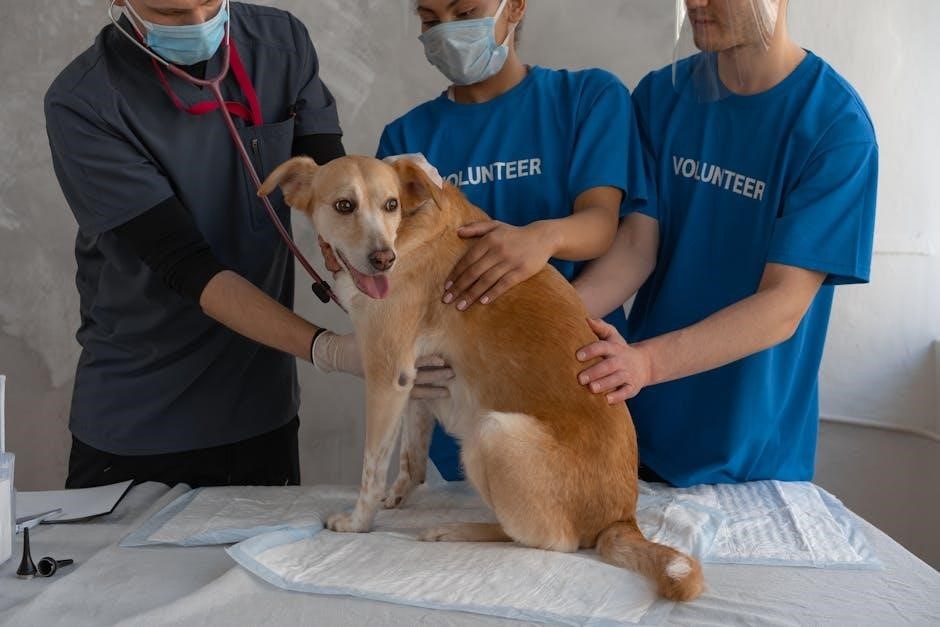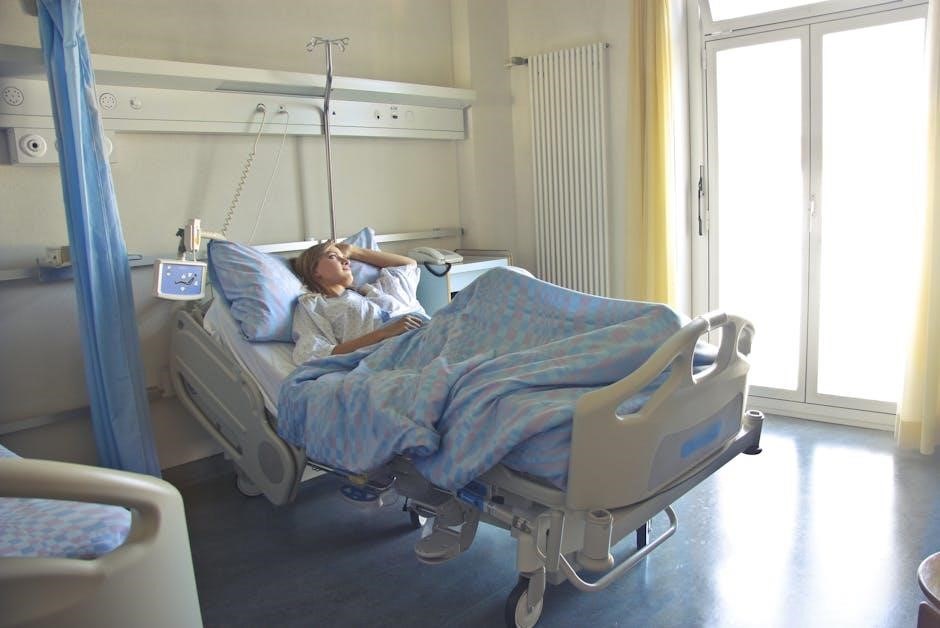1.1 Definition and Purpose
The Anointing of the Sick is a Catholic sacrament offering spiritual healing, strength, and grace to the ill. It involves prayer, anointing with sacred oil, and blessings, emphasizing God’s care for the vulnerable. This sacrament, administered by a priest, is not limited to the dying but also brings comfort and healing to the sick, uniting their suffering with Christ’s;
The Anointing of the Sick is a sacrament that offers spiritual healing and strength to the ill or vulnerable. It involves prayer, anointing with sacred oil, and blessings, emphasizing God’s care for the sick. While historically associated with the dying, it is not limited to them, providing comfort and grace to those suffering, uniting their pain with Christ’s Passion, and fostering hope and spiritual renewal.
1.2 Historical Context
The Anointing of the Sick traces its roots to early Christian practices, where the Church prayed over and anointed the ill with oil. Historically known as Extreme Unction, it was primarily for the dying, offering spiritual comfort and forgiveness. Over time, its understanding evolved to emphasize healing and grace for the living, broadening its application to all the sick, not just those near death.
1.3 Importance in Catholic Tradition
The Anointing of the Sick holds profound significance in Catholic Tradition as a sacrament of healing and grace. It offers spiritual comfort, forgiveness, and strength to the ill, emphasizing God’s mercy and care. This rite reinforces the faith of the believer and the community, highlighting the Church’s role in continuing Christ’s healing ministry. It remains a vital expression of Catholic spirituality and devotion.

Theological Basis of the Sacrament
The Anointing of the Sick is rooted in God’s mercy, offering spiritual healing, forgiveness, and strength. It reflects Christ’s compassion and embodies the Church’s mission to care for the suffering, providing grace to face illness with faith and hope.
2.1 Biblical Roots
The sacrament’s origins are in Mark 6:13 and James 5:14-15, where anointing with oil is linked to healing and forgiveness. Christ’s miracles and teachings on compassion laid the groundwork for this rite, emphasizing care for the suffering. The Bible highlights God’s mercy and desire to heal, providing the spiritual foundation for the Anointing of the Sick as a means to restore body and soul.
2.2 Teachings of the Catechism of the Catholic Church
The Catechism explains that the Anointing of the Sick is a sacrament of healing, offering spiritual and physical restoration. It emphasizes the forgiveness of sins, preparation for death, and strengthening in faith; The Church teaches that this sacrament is rooted in Christ’s compassion and is administered to those facing serious illness or old age (CCC 1514). It reflects God’s mercy and love for the afflicted.
2.3 Connection to Christ’s Healing Ministry
The Anointing of the Sick is deeply rooted in Christ’s ministry of healing and compassion. Jesus often restored the sick to health, demonstrating God’s love for the suffering. This sacrament continues His work, offering spiritual and physical healing through the power of faith. The rite reflects Christ’s mercy, with the oil symbolizing His healing touch and the prayers invoking His divine presence to comfort and strengthen the afflicted.

The Rite of Anointing of the Sick
The rite involves a sacred ritual of prayer, anointing with holy oil, and liturgical elements to bring spiritual healing and grace to the afflicted.
3.1 Liturgical Elements
The rite includes prayer, Scripture readings, and the anointing with sacred oil, blessed by the bishop. It incorporates liturgical elements like the Liturgy of the Word, prayer over the sick, and the anointing itself. The sacrament is often celebrated with the community, emphasizing the Church’s solidarity with the afflicted. The liturgical elements underscore the healing and spiritual strength provided through the sacrament.
3.2 The Role of Sacred Oil
The sacred oil used in the Anointing of the Sick is blessed by the bishop, typically during Holy Week. It symbolizes healing, comfort, and spiritual strength. The oil is applied to the sick person’s hands, feet, or forehead, depending on cultural practices. This tangible element connects the sacrament to Christ’s healing ministry, serving as a visible sign of God’s grace and mercy, offering hope and renewal.
3.3 Prayers and Blessings
The rite includes specific prayers and blessings that invoke God’s healing grace. These prayers are rooted in liturgical tradition and are recited by the priest during the anointing. They ask for physical healing, spiritual strength, and peace. The prayers also express trust in God’s mercy and compassion, offering comfort to the sick and their loved ones, reinforcing faith and hope in times of suffering.
3.4 Communal Celebration
The Anointing of the Sick can be celebrated communally, especially in parishes or care facilities. This rite emphasizes the Church’s support for the sick and fosters a sense of unity among the faithful. The congregation participates through prayers, responses, and intercessions, demonstrating the community’s solidarity with those who are ill. This collective celebration highlights the Church’s role as a caring and compassionate family.
Who Can Receive the Sacrament?
The sacrament is for the seriously ill, those facing severe health struggles, or the elderly. It offers spiritual strength and healing grace to the afflicted.
4.1 Eligibility Criteria
The Anointing of the Sick is reserved for baptized Catholics facing serious illness, near death, or significant health decline. It is not limited to the terminally ill but includes those in need of spiritual or physical healing. The sacrament is intended for those who have reached the use of reason, though exceptions exist for infants in danger of death. The focus is on providing grace and comfort to the afflicted.
4.2 The Role of the Sick Person
The sick person plays an active role in the sacrament by preparing spiritually, expressing faith, and receiving the anointing with an open heart. They are encouraged to confess serious sins beforehand if possible. Participation involves responding to prayers and embracing the grace offered. The sacrament strengthens their spiritual resolve, fostering trust in God’s healing power and presence during their illness.
4.3 Special Cases (e.g., Near Death)
In cases where death is imminent, the Anointing of the Sick takes on a profound significance, offering spiritual comfort and preparation for eternal life. The sacrament is administered with urgency, emphasizing forgiveness of sins and divine mercy. Even if the person is unconscious, the rite can still be performed, trusting in God’s grace. This sacred moment strengthens the soul in its final journey.

The Minister of the Sacrament
The sacrament is administered by an ordained priest, who acts in the person of Christ, offering spiritual healing and grace to the sick through the rite.
5.1 Role of the Priest
The priest, as an ordained minister of the Church, administers the sacrament with sacred oil, invoking God’s grace for healing and strength. They recite specific prayers, offering spiritual comfort and forgiveness. The priest’s role is both liturgical and pastoral, serving as a spiritual healer in Christ’s name, while also providing emotional and spiritual support to the sick and their families.
5.2 Responsibilities of the Minister
The minister, typically a priest, must prepare the rite, ensuring the use of consecrated oil. They are to pray with the sick, offering spiritual comfort and forgiveness. The minister’s duties include reciting prescribed prayers, anointing the senses, and providing emotional support. They also assess the appropriateness of administering the sacrament, ensuring it aligns with Church teachings and the needs of the individual.
5.3 Spiritual Preparation
The minister must engage in spiritual preparation, reflecting on the sacrament’s meaning and their role as Christ’s instrument. Prayer and meditation are essential to ensure a compassionate and reverent administration of the rite. The minister should seek guidance from the Holy Spirit, fostering a deeper connection with the sick person’s spiritual needs. This preparation ensures the sacrament is administered with empathy and sincerity.

Practical Considerations
Practical considerations include ensuring the availability of sacred oil, maintaining a calm environment, and coordinating with healthcare providers to facilitate the sacrament’s administration effectively.
6.1 When to Administer the Sacrament
The sacrament is administered when a person faces serious illness, injury, or significant health decline, such as before surgery, in advanced age, or terminal conditions. It is not reserved solely for the dying but for anyone in need of spiritual and physical healing. The sacrament can be repeated if the person’s condition worsens or improves and then deteriorates again, ensuring ongoing spiritual support.
6.2 Where the Rite is Performed
The rite is typically performed in a church, home, hospital, or wherever the sick person is present. It is ideally conducted in a sacred space with access to sacred oils. The setting should foster a prayerful atmosphere, emphasizing the sacred nature of the sacrament. The location is chosen for the comfort and accessibility of the sick person, ensuring they can fully participate.
6.3 Preparing the Sick Person
The sick person should be prepared spiritually and physically. They are encouraged to confess their sins if possible and receive Holy Communion. The area for the rite should be clean and dignified, with a crucifix and sacred oils present. The priest ensures the sacred oil is blessed and ready for the anointing. The sick person’s comfort and ability to participate are prioritized.

Pastoral Guidelines
Pastoral care for the sick involves compassion, empathy, and spiritual support. Priests provide comfort, prayer, and guidance, addressing fears and anxieties with gentle sensitivity.
7.1 Compassion and Empathy
Compassion and empathy are central to pastoral care in the Anointing of the Sick. Priests must approach the sick with kindness, understanding, and a genuine presence, reflecting Christ’s love. Active listening and emotional support help alleviate the sick person’s burdens, fostering trust and comfort. Empathy deepens the spiritual connection, allowing the priest to address the individual’s unique needs and fears with sensitivity and care.
7.2 Accompanying the Sick
Accompanying the sick involves more than administering the sacrament; it requires emotional and spiritual support. Priests should offer a comforting presence, listening to concerns and providing reassurance. This ministry fosters a sense of connection to the faith community and to God. By walking beside the sick, priests embody Christ’s compassionate care, bringing hope and strength during life’s most vulnerable moments.
7.3 Addressing Fears and Anxieties
Addressing fears and anxieties is a vital aspect of the Anointing of the Sick. Priests offer comfort and reassurance, helping the sick confront their worries with faith. Prayers and blessings provide solace, reminding them of God’s mercy and healing presence. This sacrament strengthens the soul, fostering hope and peace amidst uncertainty, and reaffirms trust in divine providence.

The Role of the Community
The community plays a vital role in supporting the sick through prayer, presence, and practical assistance, embodying Christ’s compassion and fostering a sense of belonging and care.
8.1 Supporting the Sick
The community plays a vital role by offering emotional, spiritual, and practical support to the sick, enhancing their well-being. Through visits, shared prayers, and assistance with daily needs, members embody Christ’s compassion, fostering unity and hope. Their presence reminds the sick they are valued, comforting them in difficult times and strengthening their faith.
8.2 Prayer and Intercession
Prayer and intercession are essential expressions of the community’s support for the sick, offering spiritual strength and comfort. Through communal prayer, the faithful unite with the sick, seeking healing and peace. Intercessions during Mass or in private devotion foster a deeper connection, emphasizing trust in God’s mercy and grace. This spiritual accompaniment uplifts the sick, reminding them of Christ’s healing presence.
8.3 Participation in the Rite
Participation in the Anointing of the Sick involves the community attending the ceremony, offering prayers, and providing spiritual support. The faithful are encouraged to sing, respond to prayers, and be present for the sick. This collective involvement strengthens the bond of faith and demonstrates compassion. It also emphasizes the sacrament’s communal nature, fostering unity and hope for healing and divine grace.

Official Documents and Resources
The Catechism of the Catholic Church, Canon Law, and liturgical texts provide authoritative guidance on the Anointing of the Sick, ensuring proper administration and understanding of the sacrament.
9.1 The Catechism of the Catholic Church
The Catechism of the Catholic Church outlines the Anointing of the Sick as a sacrament of healing, offering spiritual strength to the faithful in times of illness or old age. It emphasizes the sacrament’s purpose, its biblical roots, and the use of sacred oil. The Catechism also provides guidance on when and how to administer the sacrament, ensuring it aligns with Catholic doctrine and tradition.
9.2 Canon Law and the Sacrament
Canon Law establishes the legal framework for the Anointing of the Sick, ensuring its proper administration. According to Canon 1000-1003, only bishops and priests can administer the sacrament using consecrated oil. The law also specifies that the sacrament is for the seriously ill or those nearing death, emphasizing the Church’s commitment to spiritual and physical healing through divine grace and sacramental authority.
9.3 Liturgical Texts
Liturgical texts for the Anointing of the Sick are found in the Ritual or Roman Ritual, providing prayers, chants, and readings. These texts guide the sacrament, emphasizing healing, forgiveness, and spiritual strength. They include blessings of oil, liturgies of the word, and Eucharistic celebrations. The texts ensure the rite is conducted with reverence and fidelity to Catholic tradition, fostering unity and devotion among the faithful.

The Sacrament in Times of Crisis
The Anointing of the Sick offers spiritual relief during crises, providing hope and strength to the afflicted. It adapts to emergencies, ensuring God’s healing presence remains accessible.
10.1 Historical Examples
Historically, the Anointing of the Sick has been a source of comfort during plagues, wars, and epidemics. The early Church emphasized visiting and anointing the sick, as seen in James 5:14-15. During the Middle Ages, the sacrament became more formalized, with the use of holy oil and prayers for healing. The Council of Trent reaffirmed its importance, ensuring its continued practice in times of crisis and human suffering.
10.2 Modern-Day Applications
Today, the Anointing of the Sick is administered in hospitals, homes, and parishes, offering spiritual and emotional healing. It is especially significant for the elderly, terminally ill, and those facing serious health crises. The sacrament provides comfort, grace, and peace, strengthening faith and hope. Its modern application remains a vital expression of the Church’s compassion and care for the suffering, adapting to contemporary needs while preserving its sacred tradition.
10.3 Challenges and Adaptations
The sacrament faces challenges in modern times, such as limited access to priests in remote areas and the need for privacy in hospital settings. The COVID-19 pandemic highlighted the importance of adapting the rite, with some churches using technology to administer blessings remotely. Despite these challenges, the Church continues to find ways to preserve the sacrament’s integrity while addressing contemporary needs and ensuring the spiritual well-being of the faithful.
Cultural and Liturgical Variations
Cultural and liturgical variations reflect the diversity of Catholic traditions worldwide, with regional practices and devotional expressions enriching the sacrament while maintaining its essential spiritual purpose.
11.1 Regional Practices
Regional practices in the Anointing of the Sick vary globally, reflecting local customs and traditions. In some cultures, the rite incorporates processions or communal prayers, while others emphasize private administration. Latin American traditions may include elaborate rituals, while Asian communities might integrate incense or chanting; These practices enrich the sacrament, ensuring its universal message resonates within diverse cultural contexts while maintaining its spiritual essence and liturgical integrity.
11.2 Ritual Differences
Ritual differences in the Anointing of the Sick vary in execution and emphasis across regions. Some traditions include multiple anointings, while others focus on a single anointing of the hands or forehead. Prayers and blessings may differ, reflecting local devotions. Sacred objects, like crucifixes or relics, are sometimes incorporated. These variations highlight the sacrament’s adaptability while preserving its core meaning and purpose in different liturgical and cultural settings worldwide.
11.3 Devotional Practices
Devotional practices surrounding the Anointing of the Sick often include prayers for the sick, use of holy water, and recitation of the Rosary. Families and caregivers may also invoke saints associated with healing. These practices offer comfort and spiritual strength to the afflicted, reinforcing the sacrament’s purpose of healing and preparing the soul for eternal life.

The Significance of Anointing in the Church Today
12.1 Evangelization Through the Sacrament
The Anointing of the Sick evangelizes through the priest’s ministry, offering comfort and hope. It witnesses God’s love, inspiring faith and conversion in the community.
The Anointing of the Sick is a powerful tool for evangelization, bringing hope and comfort to the suffering. It reminds believers of God’s mercy and love, inspiring spiritual renewal. Through this sacrament, the Church reaches out to those in need, offering healing and strength. It also serves as a witness to the faith, inviting others to encounter Christ’s compassionate love.
This rite not only nurtures the sick but also strengthens the community’s belief in God’s healing presence. By administering the sacrament, the Church proclaims the Gospel of hope and salvation, even in times of illness and sorrow. It is a profound expression of faith that can lead to conversion and a deeper relationship with God.
The Anointing of the Sick, as outlined in the anointing of the sick rite pdf, emphasizes the importance of prayer and intercession. It encourages the faithful to trust in divine providence and to seek spiritual healing alongside physical well-being. This sacrament, therefore, plays a vital role in the Church’s mission to evangelize and bring solace to all people.
12.2 Promoting Healing and Hope
The Anointing of the Sick offers spiritual comfort and hope to those facing illness or death; It reminds the faithful of God’s merciful love and the possibility of healing, both spiritual and physical. This sacrament strengthens the sick, granting peace and courage, while also fostering hope in eternal life. It is a powerful reminder of Christ’s presence in times of suffering.
12.3 Strengthening Faith
The Anointing of the Sick strengthens faith by reminding the faithful of God’s merciful presence, even in suffering. It fosters trust in divine providence and offers spiritual comfort, renewing hope and courage. Through this sacrament, believers experience God’s grace, which deepens their faith and helps them embrace their crosses with perseverance, trusting in eternal life and the promise of salvation.
